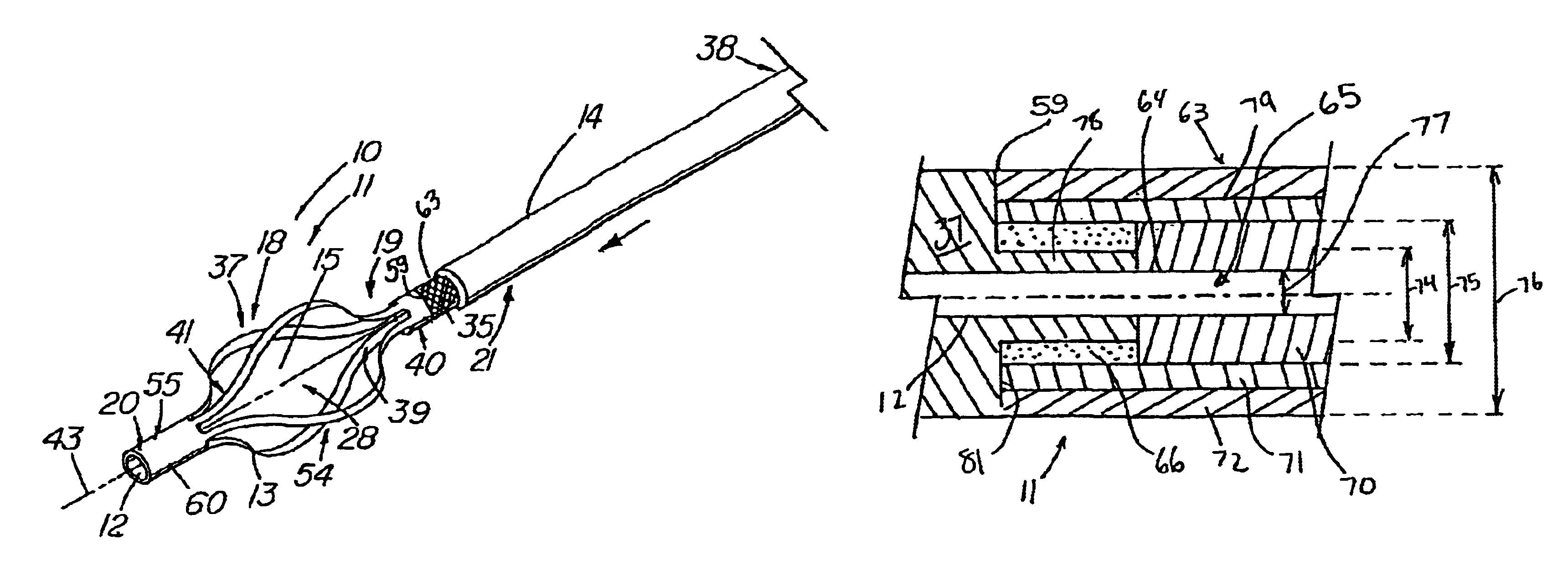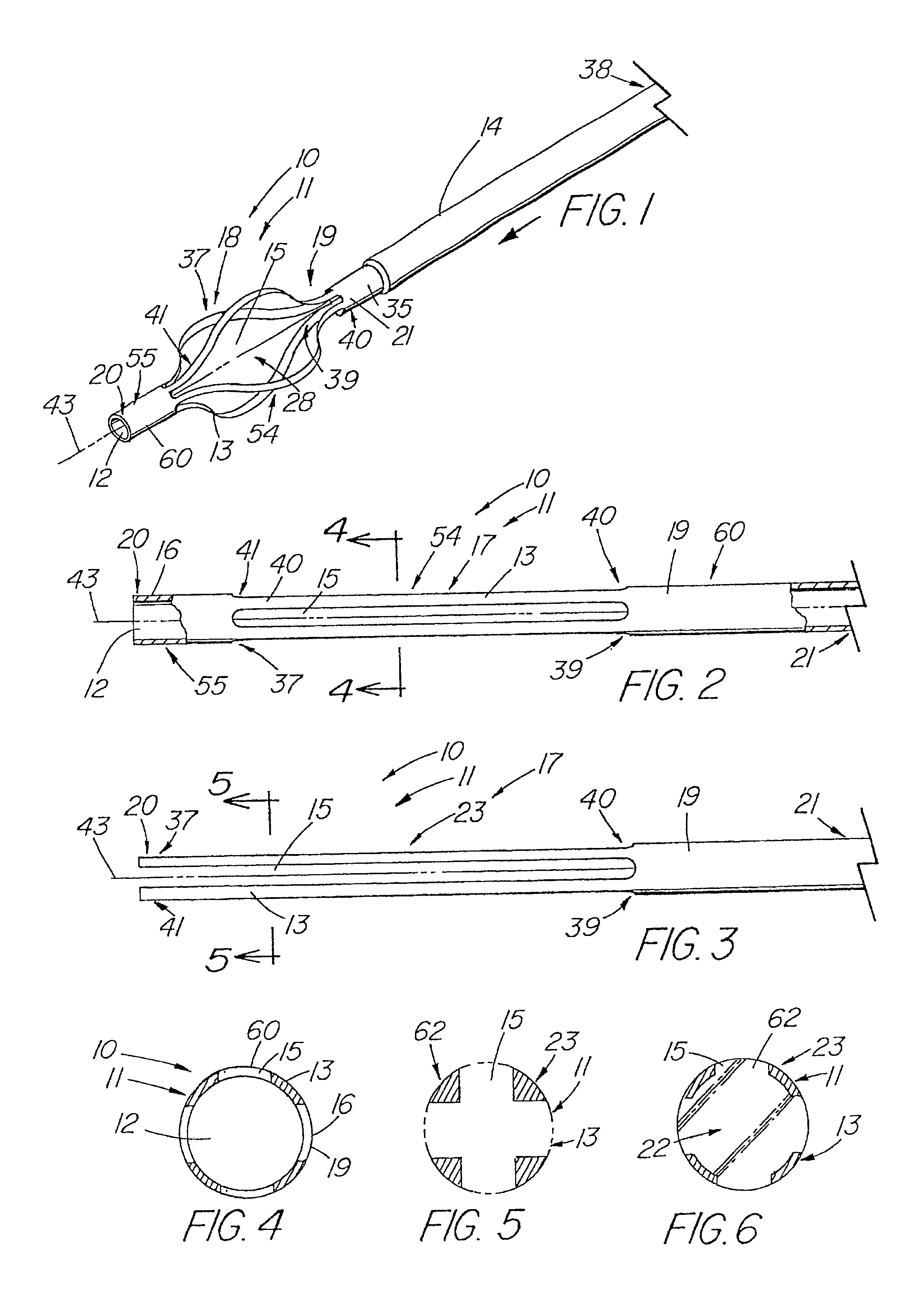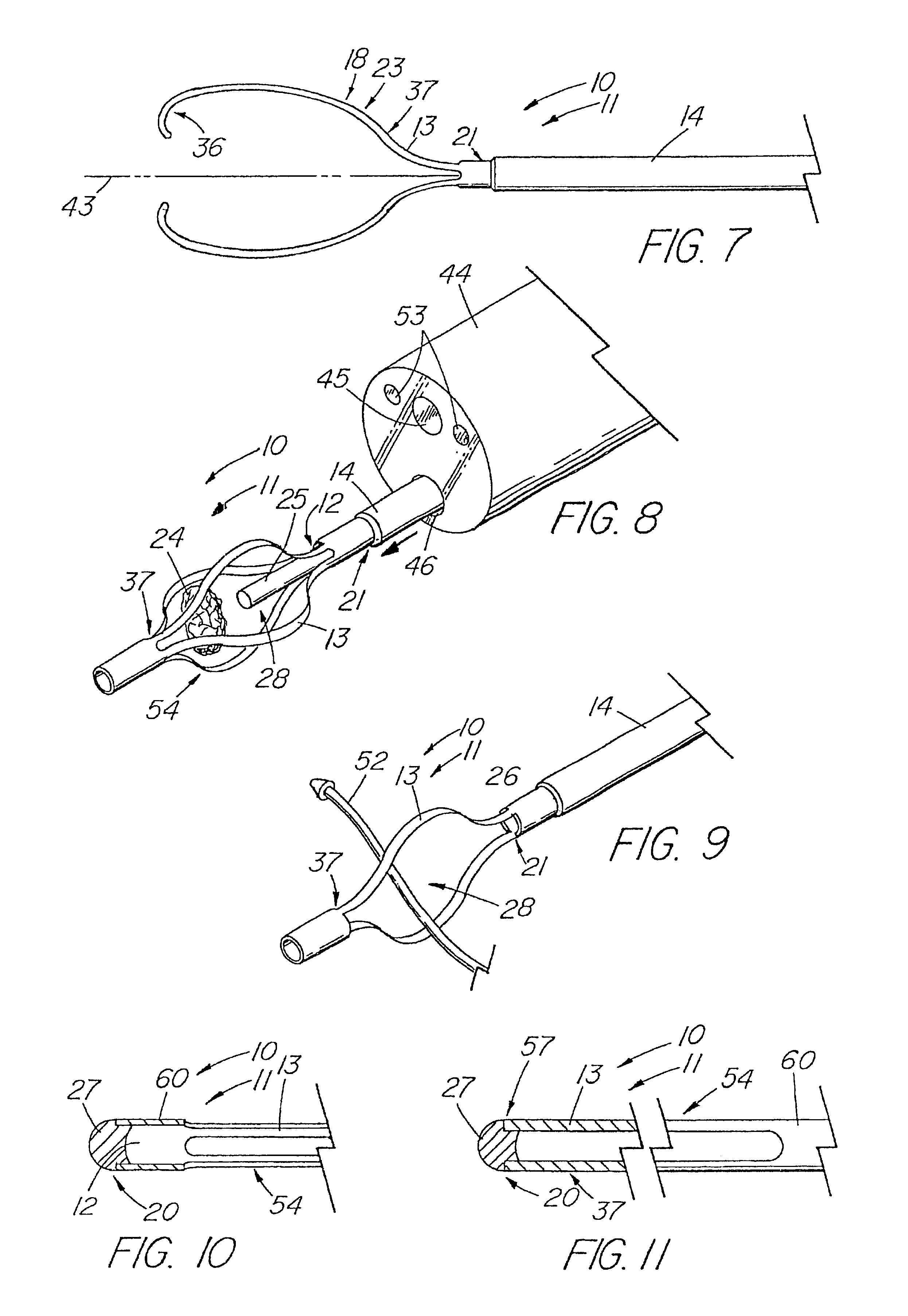[0010]
Visualization of the target object is essential when using a retrieval device. Endoscopes, used in most
minimally invasive procedures to retrieve stones or calculi, typically have a second or third accessory channel or lumen for introducing ancillary devices to the treatment site. The smaller
diameter endoscopes, such as a
ureteroscope, have a very narrow accessory channel through which the retrieval device is fed. An
advantage of the present invention is that the tubular design, with its large central lumen, allows the introduction of additional
instrumentation useful to the procedure such as a guidewire that may be used for placement, or a device to break up a stone or calculus such as a
laser fiber or electrohydraulic
lithotripsy wire. Conventional basket or grasper
forceps manufacturing techniques that require
soldering basket wires to the device shaft and / or compacting the basket wires into a narrow
diameter, do not leave sufficient additional room for other devices within the narrow working channel. While the central lumen is useful for introducing instruments into the inner working area, alternative embodiments include filling the end of the cannula with solder or another material to form a tip that is less traumatic to tissue.
[0011]An additional
advantage of the present invention is the relative simplicity of construction. Devices comprised of a
metal cannula or cylinder can be formed by making a series of longitudinal slots or slits through the cannula / cylinder to form individual resilient grasping members. The process results in perfectly aligned grasping members and, except for reforming the grasping members, eliminates much of the skilled hand work normally required to assemble a basket or grasper
forceps. Plastic deformation or
heat setting the resilient grasping members into the outwardly extending configuration of a basket or forceps advantageously removes bending stresses and puts the expanded device in a relaxed condition during deployment. Retrieval devices of the present invention can use an external constraining mechanism such as a coaxial outer sheath or
endoscope to open and close the resilient grasping members which capture and retain the target object for removal from a patient.
Alternative methods could include an actuating member disposed in the lumen of the device to open and close the basket or grasper forceps, or forming only one slot or slit into the side wall at the distal end portion.
[0012]In another embodiment of the present invention, the retrieval device is formed from an elongated member comprising a plastic tube having reinforcement wire encased therein. These wires, each representing a continuum of material extending the length of the
distal portion of the elongated member, are exposed within the
distal portion of the tube that interconnects them, where they are then formed into the resilient grasping members for making a retrieval basket or
grasping forceps.
[0013]Factors affecting the ability of an operator to percutaneously engage and / or remove stones, calculi, and the like include the strength of the grasper portion of the equipment to retain and remove the stones, and the capacity to break larger stones for removal while protecting the equipment from the energy used to break the stones. In addition, the use of a
laser or other
lithotripsy device has conventionally required a large central lumen through which a clad fiberoptic cable is passed to address the stone. A basket or grasper made of a
metal such as stainless steel of the 300 or 400 series or a
nickel-
titanium alloy such as nitinol and having a
metal shaft extending back to the proximal end defining the central lumen, provides strength to
handle and remove stones from a patient's body. The metal structure extending from the proximal end of the device to the distal end of the grasper or basket and surrounding the central lumen, protects the
endoscope and surrounding tissue from
laser energy which may be misdirected due to a defect in the
laser fiber. A defect such as a nick in the
fiber could direct the laser energy into the side wall of the
endoscope, damaging the instrument and destroying its functionality. The use of a metal structure for the distal portion of the elongated member and a lightweight, flexible material such as a coated wire
braid comprising the proximal portion, or shaft, overcomes these challenges to removing stones and calculi from a patient's body.
[0014]Where a second material is used for the proximal portion of the elongated member, or shaft of the retrieval device, the second material may be selected for its flexibility, cost and strength. The shaft made of the second material is attached to the distal portion of the elongated member comprising the grasping members to form a multi-part retrieval device. Retrieval devices of the present invention can use an external constraining mechanism such as a coaxial outer sheath or endoscope to open and close the resilient grasping members which capture and retain the target object for removal from a patient.
Alternative methods could include an actuating member disposed in the lumen of the device to open and close the basket or grasper forceps.
[0015]In one embodiment of the present invention, the retrieval device is formed from two pieces, each piece, the proximal portion (or shaft) and the distal portion of the elongated member, having a passage extending from end to end. The pieces are attached to form the device having their respective passages concentric to each other thereby forming a central, continuous lumen through the entire retrieval device from the proximal end of the shaft to the area
proximate to the basket, grasper or forceps. This central lumen is used to extend a
fiber optic wire or
lithotripsy wire from a power supply, controlled by an operator outside the patient, to a position
proximate to an object in the grasp of the basket, grasper or forceps.
 Login to View More
Login to View More  Login to View More
Login to View More 


